Diamond Glass Company 102's
by Morgan Davis
Reprinted from "Crown Jewels of the Wire", February 1986, page 20
I began collecting insulators when a couple of common pieces caught my eye at
a garage sale. I picked up a clear Pyrex and a Dominion-42 for 25 cents each and
soon began hunting for glass. When I had accumulated 35 or so pieces, I figured
that I must have had just about every type made. Was I in for a shock!
I found a reference in an antique magazine to "The Glass Insulator -- A
Comprehensive Reference" and ordered it. Well sir, that opened up a whole
new world for me. So I figured right quick that I had better specialize. Among
the insulators I had at that point were a few CD 102 Diamond ponies. These
particular insulators really appealed to me. The glass seemed very old and
crude, the embossings also varied greatly, and they were compact. (I live in a
very small apartment!)

Soon after my decision to specialize in Diamond ponies, I was working in
London, Ontario. I am a musician and traveling from town to town gives me lots
of time to go huntin' during the daytime. I was cruising the surrounding
countryside for antique and junk stores and came upon a small out of the way
shop. The couple who ran it was in their 70's and had amassed a fantastic museum
quality collection of tin and wood primitives. I spent over three hours taking
the "tour" of their collection. (Time flies when you're having fun!)
The highlight of my day came when, after inquiring about insulators, the owner
directed me to a couple of large boxes filled with glass telephone insulators he
had picked up from lines downed in storms. To my delight, most of them were CD
102 Diamonds! I had a ball going through them, and for $1 each I added 30
different Diamond ponies to my few pieces back home. I was one happy boy! Most
were what I now know as the common colors, but they were all in VNM or better
condition. That lot of glass was the foundation of my present collection. I did,
however, find a few gems in that bunch, such as: a teal blue with amber swirls;
a nice light, bright olive tone; and a couple of the crudest blackglass pieces
I've seen. One has the appearance of elephant skin, all folded and wrinkled. The
other has a very crude, lopsided  on front and back. on front and back.
By now I was bit bad! Like they say, he might get better...but he'll never
get well!
At this time I have over 80 color/embossing variations of the single  CD 102,
as well as 7
CD 102,
as well as 7  front and back varieties and over 20 front and back varieties and over 20
 and and  types. Along with the many
styles of embossing (I have over 40 varieties), some of these insulators have
mold numbers on the back lower skirt and on top of the dome. (I have found 18
different ones). There's a lifetime of searching cut out for the serious CD 102
Diamond collector. As you can see, the possibilities are endless!
types. Along with the many
styles of embossing (I have over 40 varieties), some of these insulators have
mold numbers on the back lower skirt and on top of the dome. (I have found 18
different ones). There's a lifetime of searching cut out for the serious CD 102
Diamond collector. As you can see, the possibilities are endless!
In this article I will attempt to classify just the single  CD 102 into the
mold styles I have so far encountered. This is by no means definitive, as I have
only collected for three years. Any help, information or additions are
encouraged.
CD 102 into the
mold styles I have so far encountered. This is by no means definitive, as I have
only collected for three years. Any help, information or additions are
encouraged.
First, a little history. The Diamond pony was what I call the "second
wave" of insulators in Canada's telephone line development that were used
by many independent telephone companies as well as the Bell Telephone Company of
Canada. Since they were all made in a three-piece mold, that would date them no
earlier than 1890 when the three-piece mold was developed. (Thanks, Eric
Halpin!) The earliest phone insulators in Canada were made in a two-piece mold,
and several varieties of unembossed, MLOD ponies were used from 1878 to 1890.
Their manufacturer remains a mystery, except for one variety with a curved under
base which has been attributed to the Hamilton Glass Company. This makes sense
to me, as the base style is very similar to the CD 162 Hamilton Glass insulator.
Also, the time period fits as Hamilton Glass was in operation from 1865 to 1895.
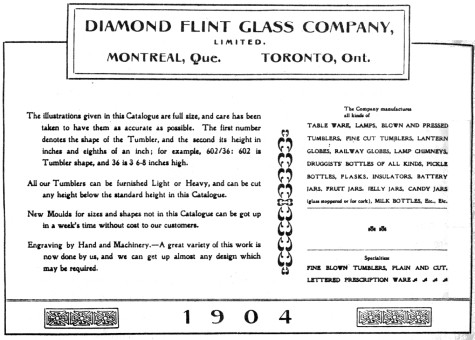
But let's get back to the Diamond pony! They were manufactured by the Diamond
Glass Company originally of Montreal, Quebec at DeMontiguy and Parthenais
Streets. In 1901 it became the Diamond Flint Glass Company and branched to
Toronto, Ontario, as well. In 1913, Diamond was amalgamated into the giant
Dominion Glass Company (which bought smaller glass houses all over Canada -- a
Wallaceburg and Sydenham Glass were among those purchased). It's my feeling that
the pre-1913 CD 102s manufactured by Diamond were what I classify as Mold Styles
I, II, and III. After the Dominion takeover, I believe that these molds were
discarded and Mold IV replaced them. The uniformity of glass color also
indicates the standardization that took place, and the use of selenium to get
that typical Dominion straw color leads me to believe that Mold IV can be dated
around 1913 to 1917. These Mold IV ponies, though markedly different in design,
were still embossed with only a single  . In 1928 the . In 1928 the
 trademark was adopted and
the CD 106 pony had replaced the CD 102. My guess is that the CD 102 trademark was adopted and
the CD 106 pony had replaced the CD 102. My guess is that the CD 102  , with a
single diamond only (with a few exceptions), were made from 1890 to 1913, a
space of only 23 years. , with a
single diamond only (with a few exceptions), were made from 1890 to 1913, a
space of only 23 years.
I have listed the four mold styles and their identifying characteristics.
Also listed are the most common colors in which they appear. I hope this guide
will give assistance to many collectors. I have also compiled a list of all the
color shades I have accumulated so far. Needless to say, naming colors is very
arbitrary, so the shades listed are relative only to this insulator family.
Along with the colors listed, amber swirls are quite common in CD 102  ,
especially in the teal shades which are beautiful insulators! ,
especially in the teal shades which are beautiful insulators!
MOLD STYLE CLASSIFICATIONS
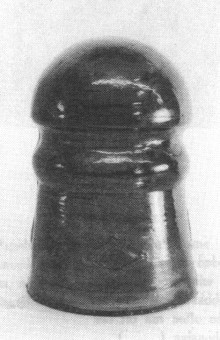 |
| Characteristics |
Colors |
| Mold I |
Round dome |
Dark olive |
|
Gentle wire groove ridge |
Blackglass ambers |
|
Crude , crude glass |
Pale green aqua |
|
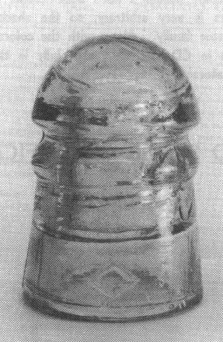 |
| Characteristics |
Colors |
| Mold II |
Flat-sided dome, short and "squat" |
Dark greens and olives |
|
Sharper wire groove ridge embossed lower on skirt, lines often run off the
embossing ( ) |
|
|
Creased, rippled, folded glass |
|
|
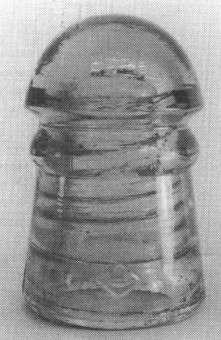 |
| Characteristics |
Colors |
| Mold III |
Large "umbrella" or "mushroom" dome |
Light greens and blues |
|
Pronounced rounded base (not always) |
|
|
Uniform, smaller |
|
|
Smooth, slick glass |
|
|
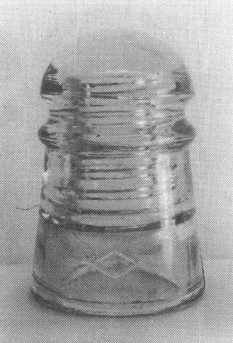 |
| Characteristics |
Colors |
| Mold IV |
Small dome |
Straw |
|
Small, sharp wire groove ridge |
|
|
High skirt |
|
|
Uniform , smooth glass |
|
|
Note: Photos for this article were provided by John LaRoque.
COLORS
|
Blackglass:
|
Olive amber
|
|
|
Red amber
|
|
|
Yellow amber
|
|
|
Brown amber
|
|
Greens:
|
Clear/Green
|
|
|
Pale Green - 2 shades
|
|
|
Lime - 4 shades
|
|
|
Chartreuse
|
|
|
Mint green
|
|
|
Olive - 7 shades
|
|
|
Dark green - 3 shades
|
|
|
Forest green
|
|
|
Kelly green
|
|
|
7-up green
|
|
|
Emerald green - 2 shades
|
|
|
"Teal" green
|
|
Yellows:
|
Clear/Yellow
|
|
|
Lemon yellow
|
|
|
Straw
|
|
Blues:
|
Clear/Blue
|
|
|
Pale Blue
|
|
|
Sky blue
|
|
|
Deep sky blue
|
|
|
Turquoise blue
|
|
|
Turquoise green
|
|
|
Teal blue
|
|
|
Midnight blue
|
|
Ambers:
|
Light "honey" amber
|
|
|
Bright gold-brown
|
|
|
Bright reddish-brown
|
|
|
Olive amber
|
|
S.C.A.:
|
Clear/Grey
|
|
|
Pale S.C.A.
|
|
|
Light S.C.A.
|
|
|
Medium S.C.A.
|
|
|
Dark S.C.A.
|
|
Purples:
|
Medium Purple
|
I know of no other insulator with a single embossing (a single) style which
appears in as many mold styles and in such a wide range of beautiful colors.
With the help of you collectors out there, I hope to submit further articles on
mold numbers and colors, as well as mold variations (drips, etc.).
|
